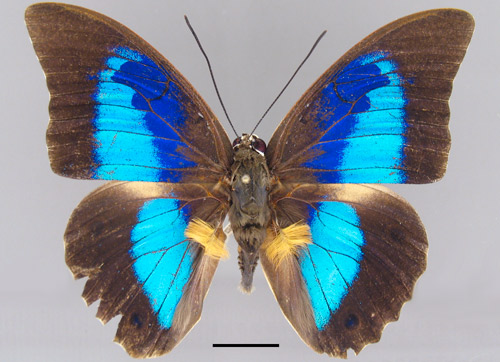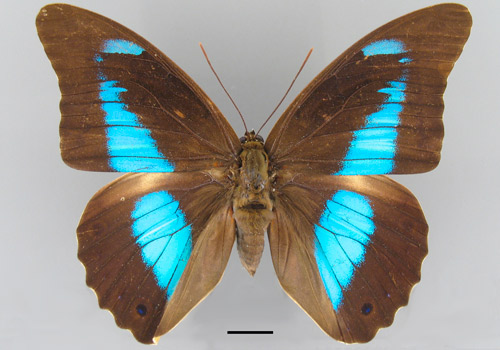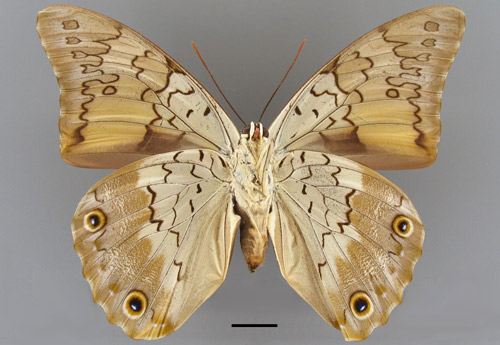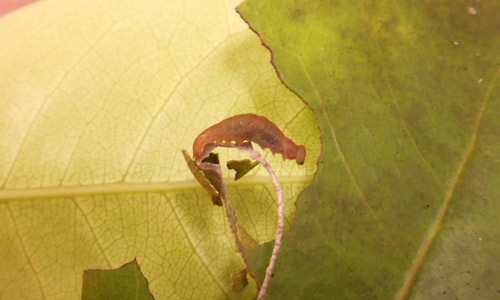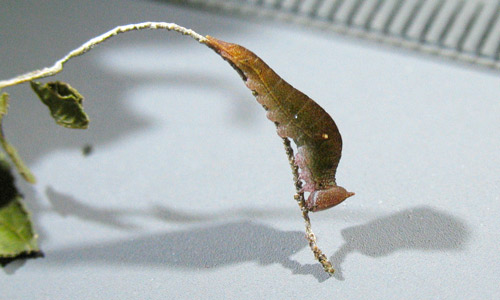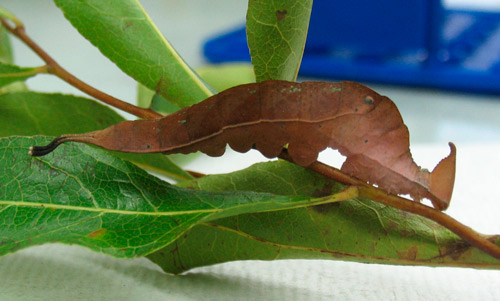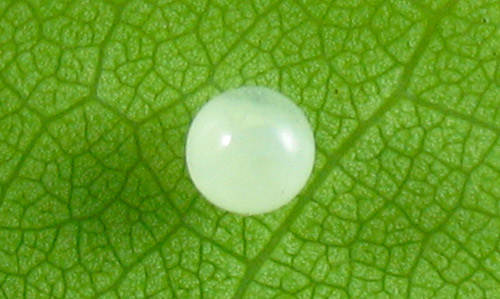common name: a shoemaker butterfly
scientific name: Prepona laertes (Hübner) (Lepidoptera: Nymphalidae)
Introduction - Distribution - Description - Hosts - Selected References
Introduction (Back to Top)
Prepona laertes (Hübner) is a butterfly native to South and Central America. In August 2013, USDA and FDACS-DPI found an established population of the species in Broward County, Florida (Hayden 2013). The caterpillars feed on leaves of cocoplum (Chrysobalanus icaco L.). The simultaneous presence of adult butterflies, eggs, and caterpillars of all stages plus an anecdotal prior sighting suggested establishment some months prior to discovery. The infestation has persisted to the present time in a localized area in Coconut Creek, Florida.
Figure 1. Male Prepona laertes from initial interception in Florida, dorsal aspect. Scale bar = 1 cm. Photograph by J.E. Hayden, Florida Department of Agriculture and Consumer Services, Division of Plant Industry.
Figure 2. Male Prepona laertes, ventral aspect. Scale bar = 1 cm. Photograph by J.E. Hayden, Florida Department of Agriculture and Consumer Services, Division of Plant Industry.
Figure 3. Female Prepona laertes from Peru, dorsal aspect (Florida Museum of Natural History). Scale bar = 1 cm. Photograph by J.E. Hayden, Florida Department of Agriculture and Consumer Services, Division of Plant Industry.
Figure 4. Female Prepona laertes, ventral aspect. Scale bar = 1 cm. Photograph by J.E. Hayden, Florida Department of Agriculture and Consumer Services, Division of Plant Industry.
Distribution (Back to Top)
The species is distributed broadly from tropical Mexico to subtropical South America. It is not present in the Antilles, and it has not been found previously in the natural environment in North America. The butterflies inhabit many types of mesic and humid forests and can exist in suburban areas in their native range (Neild 1996). It is doubtful that they tolerate temperatures below freezing.
Description (Back to Top)
Prepona laertes differs from other butterflies in Florida in wing pattern (Figures 1-5). The forewing length (base to apex) is 3.5 to 5.0 cm (1.4-2.0 inches), males being smaller. The wings are black on the dorsal side with a broad, blue medial band. Ventrally, they are grayish to tan brown with narrow, angular lines. Each hind wing has two small eyespots. Males have a large tuft of yellow hairs on the hind wing.
Figure 5. Live male Prepona laertes raised in quarantine. Photograph by J.E. Hayden, Florida Department of Agriculture and Consumer Services, Division of Plant Industry.
Figure 6. Larva of Prepona laertes, first instar on cocoplum leaf. Photograph by J.E. Hayden, Florida Department of Agriculture and Consumer Services, Division of Plant Industry.
Figure 7. Second instar larva of Prepona laertes on cocoplum leaf. Scale in mm. Photograph by J.E. Hayden, Florida Department of Agriculture and Consumer Services, Division of Plant Industry.
Figure 8. Fifth instar (mature larva) of Prepona laertes on gopher apple foliage. Photograph by J.E. Hayden, Florida Department of Agriculture and Consumer Services, Division of Plant Industry.
Figure 9. Egg of Prepona laertes on cocoplum leaf. Photograph by J.E. Hayden, Florida Department of Agriculture and Consumer Services, Division of Plant Industry.
Figure 10. Pupa of Prepona laertes. Scale in millimeters. Photograph by J.E. Hayden, Florida Department of Agriculture and Consumer Services, Division of Plant Industry.
Larvae are smooth and brown (Figures 6-8). The head has a pair of closely set horns, appearing "coneheaded." The abdomen is swollen anteriorly, thickest at the second segment. The prolegs on the last segment are rudimentary and hidden under a pair of long, crooked "tails." These features are most pronounced in older caterpillars (Figure 8), and first-instar larvae (Figure 6) cannot be distinguished easily from those of native species. Mature larvae reach lengths of 7.0-7.5 cm. The cryptic larvae move slowly with a waddling gait (DeVries 1987).
Eggs are laid singly on leaves and hatch in about a week (Figure 9). They are 2.0-2.5 mm, white and spherical. The stout green pupa (Figure 10) has a pair of horns and hangs from a branch (Muyshondt 1973). The adult emerges in 12 to 14 days.
Preliminary evidence suggests that Prepona laertes in parts of its native range may comprise at least two host races or cryptic species, one of which feeds on Fabaceae (Leguminosae), and another on Chrysobalanaceae (Janzen et al. 2009). However, morphological characters that differ consistently have not yet been found (Dias et al. 2011). Prepona laertes, as currently circumscribed, has many synonyms and subspecies (Lamas 2004), including Prepona omphale (Hübner) and Prepona laertes demodice (Godart). The genus Prepona Boisduval includes several other similar species in the Neotropical region (Ortiz-Acevedo and Willmott 2013, Warren et al. 2016).
Hosts (Back to Top)
Larvae feed on foliage of trees mainly in the plant families Chrysobalanaceae and Fabaceae. Across the native range, recorded hosts include Chrysobalanus icaco (cocoplum, hicaco), Hirtella racemosa Lam., Licania arborea Seem., Andira inermis (Wright) DC. (cabbagebark tree or angelin), Zygia longifolia (Willd.) Britton & Rose, species of Inga Mill., Melicoccus bijugatus Jacq. (mamoncillo, Spanish lime, genip, family Sapindaceae), Psidium L. (guava, guayaba, family Myrtaceae), and (doubtfully) on Coffea arabica L. (coffee, family Rubiaceae) (Beccaloni et al. 2008). In Florida, only damage to cocoplum has been observed thus far in the wild. In captivity, the larvae can consume and complete development on gopher apple (Licania michauxii Prance). This is consistent with the hypothesis that a specialist host race has been introduced. Nevertheless, any of the known hosts should be scrutinized for damage. Records of related species on Myrtaceae, although few, are enough to predict it as an alternative host family.
Behavior and Detection (Back to Top)
Larvae feed singly on leaves and generally prefer new foliage. A larva chews the distal half of a leaf, leaving the midrib or major vein intact as a resting perch. It often decorates the perch with pieces of leaves dangling on silk. Other species of nymphalid butterflies make this same pattern of leaf damage on other plants, but in Florida, only Prepona laertes is known to feed on cocoplum in this way. In other species, these perches serve as retreats for larvae to defend against predatory ants (Salvato and Salvato 2016), and they may serve the same function in Prepona laertes. Fully grown larvae consume whole leaves. The larvae grow slowly, and the whole life cycle takes about three months. In the native range, the larvae suffer from relatively low rates of parasitization by Hymenoptera and Diptera (Muyshondt 1973, Janzen and Hallwachs 2009).
Adults are strong, fast fliers and frequent the middle and upper canopy and forest edges. Males are territorial and habitually attack blue objects of similar size, mistaking them for rivals. Females lay single eggs on leaves in the shade. The characteristic feeding pattern of the larvae is easiest to observe, and the larvae are the life stage that is most likely to be found in Florida.
Examination of specimens is necessary to confirm identification and to document records. To collect a sample, place a larva in a vial of 70% isopropyl or ethyl alcohol with the damaged leaf. Adults can be attracted to rotten fruit or carrion, but the bait may be ineffective, depending on weather, the environment and individually varying butterfly behavior. Patrolling males can be attracted with blue flags and netted. Immobilize adult butterflies by firmly squeezing the thorax and place them in an envelope to avoid crushing in transit. Submit specimens with collection data to FDACS-DPI Entomology, 1911 SW 34th Street, Gainesville, Florida 32608-1021.
Similar Species (Back to Top)
Some other native nymphalid butterflies have ventrally brown wings with eyespots, but they are not dorsally blue and black. Many lycaenids (blues and hairstreaks) are dorsally blue and ventrally brown with spots, but they are much smaller. The Malachite, Siproeta stelenes (Linnaeus), has green rather than blue markings that appear ventrally as well as dorsally. In any case, an identification based on a fast-flying individual is difficult to confirm, and photographs of perching adults or a real specimen are needed.
The most similar caterpillars that feed on the same hosts are Schizura moths (Notodontidae), which have humps on the first and eighth abdominal segments and paired "tails." However, the head is not cone-shaped, and most are green and brown in color.
Much damage to cocoplum leaves is caused by beetles such as the Sri Lankan weevil (Myllocerus undecimpustulatus undatus Marshall). They notch leaf margins or chew in an irregular pattern, but they do not construct a characteristic midrib perch.
Economic Importance (Back to Top)
Prepona laertes is not reported to cause economically significant damage in its natural range, although they are abundant where Melicoccus grows in suburbs (Neild 1996). In Florida, larvae have been observed thus far on wild cocoplum. The plant is native to South Florida and is one of the most common choices for hedgerows in developments, so the butterfly has the potential to become widely distributed.
Acknowledgements (Back to Top)
Thanks to Keith Willmott (University of Florida), Susan Halbert (FDACS-DPI), Lou Somma (FDACS-DPI), Paul Skelley (FDACS-DPI), Leroy Whilby (FDACS-DPI) and Greg Hodges (FDACS-DPI) for constructive reviews, and to Jessica Awad (FDACS-DPI) for rearing larvae.
Selected References (Back to Top)
- Beccaloni, G.W., A.L. Viloria, S.K. Hall, and G.S. Robinson. 2008. Catalogue of the hostplants of the Neotropical Butterflies. S.E.A. / RIBES / CYTED / The Natural History Museum / Instituto Venezolano de Investigaciones Científicas, Zaragoza and London. 536 p.
- DeVries, P.J. 1987. The butterflies of Costa Rica and their natural history: Papilionidae, Pieridae, Nymphalidae. Princeton University Press, Princeton, New Jersey. 327 p.
- Dias, F.M.S., M.M. Casagrande, and O.H.H. Mielke. 2011. External morphology and ultra-structure of eggs and first instar of Prepona laertes laertes (Hübner, [1811]), with notes on host plant use and taxonomy. Journal of Insect Science 11: 1-10.
- Hayden, J.E. 2013. Prepona laertes, a nymphalid butterfly, a new continental USA record. P. 1, 5, 6, 10. In: Dixon, W.N. and P.J. Anderson (editors). Tri-ology 52. (30 November 2016)
- Janzen, D.H., W. Hallwachs, P. Blandin, J.M. Burns, J.-M. Cadiou, I. Chacon, T. Dapkey, A.R. Deans, M.E. Epstein, B. Espinoza, J.G. Franclemont, W.A. Haber, M. Hajibabaei, J.P.W. Hall, P.D.N. Hebert, I.D. Gauld, D.J. Harvey, A. Hausmann, I.J. Kitching, D. Lafontaine, J.-F. Landry, C. Lemaire, J.Y. Miller, J.S. Miller, L. Miller, S.E. Miller, J. Montero, E. Munroe, S. Rab Green, S. Ratnasingham, J.E. Rawlins, R.K. Robbins, J.J. Rodriguez, R. Rougerie, M.J. Sharkey, M.A. Smith, M.A. Solis, J.B. Sullivan, P. Thiaucourt, D.B. Wahl, S.J. Weller, J.B. Whitfield, K.R. Willmott, D.M. Wood, N.E. Woodley and J.J. Wilson. 2009. Integration of DNA barcoding into an ongoing inventory of complex tropical biodiversity. Molecular Ecology Resources 9: 1-26. DOI: 10.1111/j.1755-0998.2009.02628.x
- Janzen, D.H. and W. Hallwachs. 2009. Dynamic database for an inventory of the macrocaterpillar fauna, and its food plants and parasitoids, of Area de Conservacion Guanacaste (ACG), northwestern Costa Rica. (28 March 2016)
- Lamas, G. 2004. Checklist: Part 4A. Hesperioidea – Papilionoidea. In: Heppner JB, Editor. Atlas of Neotropical Lepidoptera. Association for Tropical Lepidoptera and Scientific Publishers, Gainesville, FL. xxxvi, 439 p.
- Muyshondt, A. 1973. Notes on the life cycle and natural history of butterflies of El Salvador. I. Prepona ompale victoria (Nymphalidae). Journal of the Lepidopterists' Society 27: 210-219.
- Neild, A.F.E. 1996. The Butterflies of Venezuela, Part 1: Nymphalidae I. Meridian Publications, Greenwich, London. 144 p.
- Ortiz-Acevedo, E. and K.R. Willmott. 2013. Molecular systematics of the butterfly tribe Preponini (Nymphalidae: Charaxinae). Systematic Entomology 38: 440-449. DOI: 10.1111/syen.12008
- Salvato, M.H. and H.L. Salvato. 2016. Pseudomyrmex spp. ant (Hymenoptera: Formicidae) predation on Anaea troglodyta floridalis larvae (Nymphalidae). Journal of the Lepidopterists’ Society 70: 76-78.
- Warren, A.D., K.J. Davis, E.M. Stangeland, J.P. Pelham, K.R. Willmott and N.V. Grishin. 2016. Illustrated Lists of American Butterflies. (10 January 2017)
